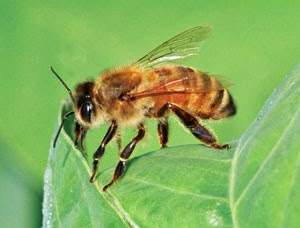 |
| Most bee stings aren't deadly. Photo courtesy of Wisconsin DNR. |
To avoid being stung, stay away from areas where bees, hornets, wasps and yellow jackets might live. Even if no hive is in sight, you usually can determine their home by watching where they disappear – behind a bush’s or tree’s leafy branches, crawling into a ground hole, or a hollow log opening.
If one flies near your children, they shouldn’t swat at it or run. This may anger the insect into stinging. Instead, remain calm and let it fly away. If it lands on your children, have them brush it off and calmly walk away.
Remove the honeybee stinger by scraping it out with a fingernail (bumblebees, hornets and wasps don’t leave a stinger and can sting repeatedly). Don’t use tweezers on the honeybee stinger as this may release more venom into the skin. Carry oral Benadryl to slow allergic reactions. However, if a severe reaction occurs – such as a bad swelling and rash in areas where the sting didn’t occur, especially on the eyes and mouth – seek medical attention immediately. If the child is allergic to bee and wasp stings, be sure to carry prescribed medications to treat it. A cold compress can be placed on the spot to reduce minor swelling.
Read more about day hiking with children in my guidebook Hikes with Tykes.
